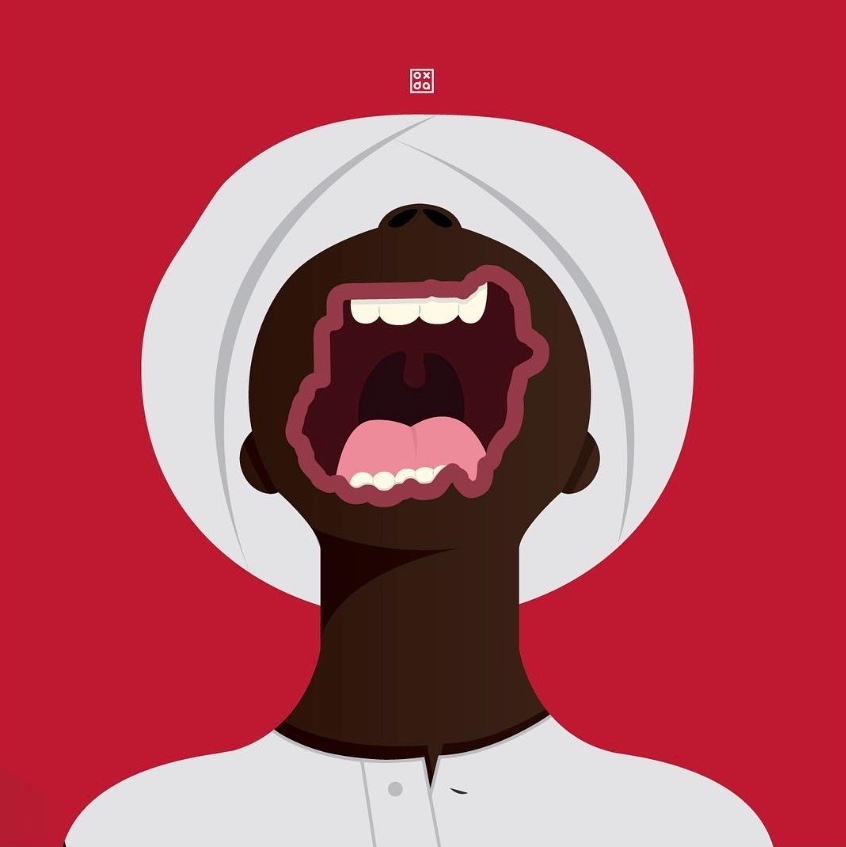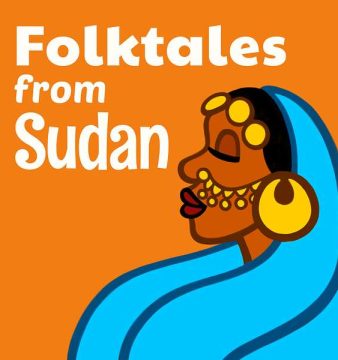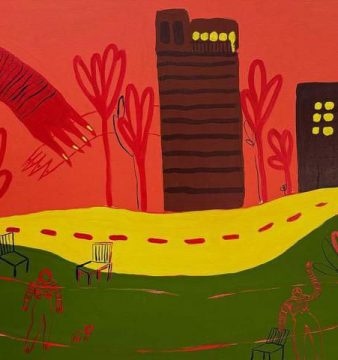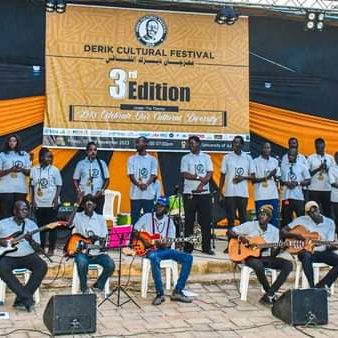Interview with Abu’Obayda Mohamed (OXDA)

Since the Sudanese revolution ignited in December 2018, a parallel art revolution was ignited as well. Sudanese artists from around the world took to Sudan’s streets as well as social media to artistically express the voices of people as well as their own.
Those following the Sudanese revolution from afar specifically on social media must be familiar with the work of artist Abu’Obayda Mohamed, who is better known as OXDA. He has more than 40,000 followers on social media with 23.5k followers on Instagram, 16,073 likes on Facebook, and 4,583 followers on Twitter). His politically-charged, patriotic and emotive artwork revolves around Sudan and its struggles, often artistically using the map of Sudan. Since the revolution began in 2018, some of his illustrations have been recognised as emblems of the revolution. The cartoonist’s artwork has been featured in many online new platforms including OkayAfrica, Dire, The Final Call and more as art that has fueled the revolution.
The 29-year-old artist is also the founder of OXDA Designs, a sustainable clothing brand of eco-friendly t-shirts, jackets, backpacks and keychains with illustrations of his artwork. He launched his first collection, Wattan, in June 2020, followed by his second collection, Sudan, in February 2021.
Abu’Obayda received a fine and applied arts bachelor’s degree in 2012 in Khartoum. He later worked in Sudan for four years before moving to the UAE where he is currently based, working as a creative director for a local company.
500 Words Magazine speaks to Abu’Obayda Mohamed about his influential art, the Sudanese revolution and his eco-friendly clothing brand, OXDA Designs.
What inspired you to become an artist?
As a child, I loved cartoons and specifically watching Cartoon Network. My love for cartoons didn’t stop as I grew up from how the characters were designed to how the scenes were animated. Everything was fascinating to me. That led me to choose fine and applied art as my study field and there I was introduced to various types of art.
I started working as a graphic designer, illustrator and cartoonist. I found myself in production sets taking decisions and paying attention to the smallest details attempting to produce and exceed expectations. I believe that creativity is a way of life, and is something I hope to incorporate in everything I do one day.
‘I believe that creativity is a way of life, and is something I hope to incorporate in everything I do one day.’
Your artwork has been iconic during the revolution and an emblem of the revolution in many ways. Although living in the diaspora, do you feel that that’s how you’ve connected with and contributed to the revolution?
Being away from my home country and family is always difficult, but especially during these hard times when I feel I could contribute more to the movement if I was home. Since I cannot join my people in protests on the streets, I use my skills and love of drawing to try to fulfil my civic duty somehow and contribute to the revolution. Revolution is a collaborative process between people and each person plays a part. I try to spread the messages of the Sudanese people on social media to share with the world what my people are experiencing and achieving each time. It’s nothing compared to those risking their lives and safety on the ground; however, I attempt to also show my people that those of us abroad are behind them and supporting them each step of the way.
‘Revolution is a collaborative process between people and each person plays a part.’
Walk us through how the revolution inspired your recent artwork and how it has impacted your brand?
The revolution gives me hope. It gives us a chance to see that our dreams of building a new Sudan, free of war, oppression, injustice and inequality, is not just a dream but a reality we can reach. The revolution is like the moon light, shining brightly through the darkest nights we lived, constantly reminding us that despite the darkness around us, our light remains to guide us towards a better future. The people of Sudan and our resilience and determination to achieve what we set out to in December 2018, has kept me hopeful and patient to see our revolution through.
The Sudan revolution ignited a parallel art revolution in the country. How important do you think art is during a revolution, and what impact or role did art play during the Sudanese revolution?
When look at our history, art has always been used to tell a story. People in the past used art to tell us about their daily lives and the things that mattered to them. During times of revolution, art can be used as an archive to document the current situation, by elevating the voices of the people, and giving future generations information about our revolution. It demonstrates what we are facing and how we are fighting to get freedom, peace and justice. In many ways, art is also a digestible language for the masses. Anyone can look at a work of art and relate to it without having much context or background. Context enhances the work and its meaning but in many ways the work speaks for itself and can relate to many people facing the same barriers globally. Art can change everything. Art is everything! Art always plays a very strong influential role in any movement.
‘During times of revolution, art can be used as an archive to document the current situation, by elevating the voices of the people, and giving future generations information about our revolution.’
Your artwork usually consists of the Sudanese map. That’s your signature. Tell us what’s the concept behind it?
When I started the Sudan map project I was thinking of drawing 89 pieces using the map of Sudan as my starting point. The significance of the number 89 was pulled from 1989, the year the former Sudanese President Omar Al Bashir came to power through a military coup. The map of the country has changed through the course of the last 30 years, with South Sudan becoming an independent state, but the significance of it still remains. Using the map of the entire country highlights that as an entire country much of our struggles, experiences and even aspirations for our country remain the same. Despite our differences, what unifies us is our shared land and history.
‘Despite our differences, what unifies us is our shared land and history.’
You’ve recently launched OXDA Designs. Tell us more about it, and what inspired you to launch it? Are there plans to make your products available in Sudan and expand worldwide?
The main concept of OXDA Designs was to launch a youth-led company that mainly works with sustainable and eco-friendly products from the fabric of the cloth to the ink printing and packaging. As young people, we need to take our environment and take care of it in every step we take. With the move towards sustainability and environmentally conscious products and practices, we can guarantee a better earth for future generations and even for us as the effects of climate change are currently surfacing. In 20 years, most of the companies will be eco-friendly and that’s a necessary shift from the common practices today. OXDA Designs incorporates the ideals of sustainable clothing whilst also illustrating Sudanese artwork and identity. We hope to have more products available in Sudan and to expand worldwide as we grow.
‘With the move towards sustainability and environmentally conscious products and practices, we can guarantee a better earth for future generations and even for us as the effects of climate change are currently surfacing.’
How is the brand eco-friendly and why do you think it’s important for your products to be eco-friendly?
As I’ve mentioned before, it is our responsibility to save our planet, and work towards mitigating the damage done over the last few decades. It is the only environment and home we know so at this rate we are destroying our home. Moving to another planet may happen in movies but to me, seems highly unlikely. OXDA Designs is eco-friendly in many ways. The fabric uses is organic grown materials. The aim of this standard is to guarantee the traceability and integrity of the raw materials during all the manufacturing stages The packing we use is also made with plastic poly mailer bags, and it’s completely compostable.
For more on OXDA Designs, find them on Instagram @oxdadesigns.
To follow OXDA or see more of his work, find him on social media – Instagram @oxdamoe, Facebook OXDA – Abuobayda Mohamed @oxdamoe, and Twitter @oxdamoe.




